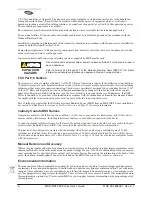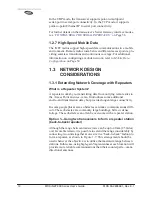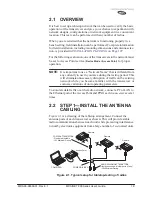
MDS 05-2806A01, Rev. E.1
MDS iNET 900 Series User’s Guide
11
Invisible place holder
Figure 1-7. Typical LAN with a Repeater Link
Overview
Two transceivers may be connected “back-to-back” through the
LAN
Ports to form a repeater station. (The cable must be a “cross-over”
Ethernet cable for this to work). This configuration is sometimes
required in a network that includes a distant Remote that would other-
wise be unable to communicate directly with the Access Point station
due to distance or terrain.
The geographic location of a repeater station is especially important. A
site must be chosen that allows good communication with both the
Access Point and the outlying Remote site. This is often on top of a hill,
building, or other elevated terrain from which both sites can be “seen”
by the repeater station antennas. A detailed discussion on the effects of
terrain is given in
Section 5.1.2, Site Selection (beginning on Page 131)
.
The following paragraphs contain specific requirements for repeater
systems.
Antennas
Two antennas are required at this type of repeater station—one for each
radio. Measures must be taken to minimize the chance of interference
between these antennas. One effective technique for limiting interfer-
ence is to employ vertical separation. In this arrangement, assuming
both are vertically polarized, one antenna is mounted directly over the
other, separated by at least 10 feet (3 Meters). This takes advantage of
the minimal radiation exhibited by most antennas directly above and
below their driven elements.
Another interference reduction technique is to cross-polarize the
repeater antennas. If one antenna is mounted for polarization in the ver-
tical plane, and the other in the horizontal plane, an additional 20 dB of
attenuation can be achieved. (Remember that the corresponding stations
should use the same antenna orientation when cross-polarization is
used.)
Network Name
The two radios that are wired together at the repeater site must have dif-
ferent network names. To set or view the network names,
see “STEP 3—
CONNECT PC TO THE TRANSCEIVER”
on Page 20
for details.
Access Point
Remote
Remote
Remote
Remote
Access
Point
LAN/WAN
REPEATER
Crossover Cable
LAN
LAN
LAN
Ethernet
POINT
-TO-POINT
LINK
Содержание iNET 900 Series
Страница 10: ...2 MDS iNET 900 Series User s Guide MDS 05 2806A01 Rev E 1 ...
Страница 26: ...18 MDS iNET 900 Series User s Guide MDS 05 2806A01 Rev E 1 ...
Страница 118: ...110 MDS iNET 900 Series User s Guide MDS 05 2806A01 Rev E 1 ...
Страница 120: ...112 MDS iNET 900 Series User s Guide MDS 05 2806A01 Rev E 1 ...
Страница 136: ...128 MDS iNET 900 Series User s Guide MDS 05 2806A01 Rev E 1 ...
Страница 148: ...140 MDS iNET 900 Series User s Guide MDS 05 2806A01 Rev E 1 ...
Страница 150: ...142 MDS iNET 900 Series User s Guide MDS 05 2806A01 Rev E 1 ...
Страница 164: ...156 MDS iNET 900 Series User s Guide MDS 05 2806A01 Rev E 1 ...
Страница 172: ...164 MDS iNET 900 Series User s Guide MDS 05 2806A01 Rev E 1 ...
















































